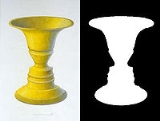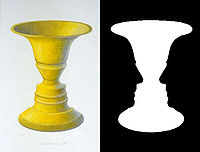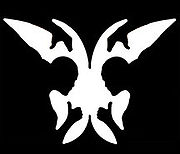
Negative space
Encyclopedia


Art
Art is the product or process of deliberately arranging items in a way that influences and affects one or more of the senses, emotions, and intellect....
, is the space around and between the subject(s) of an image. Negative space may be most evident when the space around a subject, and not the subject itself, forms an interesting or artistically relevant shape, and such space is occasionally used to artistic effect as the "real" subject of an image. The use of negative space is a key element of artistic composition. The Japanese
Japanese language
is a language spoken by over 130 million people in Japan and in Japanese emigrant communities. It is a member of the Japonic language family, which has a number of proposed relationships with other languages, none of which has gained wide acceptance among historical linguists .Japanese is an...
word "ma
Ma (negative space)
Ma is a Japanese word which can be roughly translated as "gap", "space", "pause" or "the space between two structural parts." The spatial concept is experienced progressively through intervals of spatial designation. In Japanese, ma, the word for space, suggests interval...
" is sometimes used for this concept, for example in garden design
Garden design
Garden design is the art and process of designing and creating plans for layout and planting of gardens and landscapes. Garden design may be done by the garden owner themselves, or by professionals of varying levels of experience and expertise...
.
In a two-tone, black-and-white image, a subject is normally depicted in black and the space around it is left blank (white), thereby forming a silhouette
Silhouette
A silhouette is the image of a person, an object or scene consisting of the outline and a basically featureless interior, with the silhouetted object usually being black. Although the art form has been popular since the mid-18th century, the term “silhouette” was seldom used until the early decades...
of the subject. However,
reversing the tones so that the space around the subject is printed black and the subject itself is left blank causes the negative space to be apparent as it forms shapes around the subject, called figure-ground reversal.
Elements of an image that distract from the intended subject, or in the case of photography
Photography
Photography is the art, science and practice of creating durable images by recording light or other electromagnetic radiation, either electronically by means of an image sensor or chemically by means of a light-sensitive material such as photographic film...
, objects in the same focal plane, are not considered negative space. Negative space can be used to depict a subject in a chosen medium by showing everything around the subject but not the subject itself. Usage of negative space will produce a silhouette
Silhouette
A silhouette is the image of a person, an object or scene consisting of the outline and a basically featureless interior, with the silhouetted object usually being black. Although the art form has been popular since the mid-18th century, the term “silhouette” was seldom used until the early decades...
of the subject. Most often, though, negative space is used as a neutral or contrasting background to draw attention to the main subject which is then referred to as the positive space.
The use of equal negative space, as a balance to positive space, in a composition is considered by many as good design.
This basic and often overlooked principle of design gives the eye a "place to rest," increasing the appeal of a composition through subtle means.
The term is also used by musicians to indicate silence within a piece.
It can be a difficult concept to grasp. One tool used by art teachers in teaching about positive and negative space was popularized in the book Drawing on the Right Side of the Brain
Betty Edwards
Betty Edwards is an American art teacher and author, best known for her 1979 book, Drawing on the Right Side of the Brain. She taught and did research at the California State University, Long Beach until she retired in the late '90s...
. In the exercise, students copy from an upside-down drawing or photograph. Because the picture is upside-down, students don't readily recognize the objects in the picture. They are able to give equal attention to the positive and negative shapes. The result is often a much more accurate drawing.

